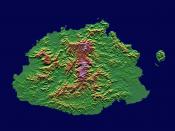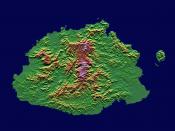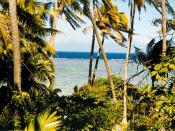The Fiji Islands, officially the Republic of Fiji Islands, is an independent island nation in the southern Pacific Ocean, located approximately 1,900 miles northeast of Sydney, Australia, and approximately 3,100 miles southwest of Honolulu, Hawaii at 16-20ÃÂ S latitude and 178ÃÂE - 178ÃÂW longitude. Fiji is often referred to as the hub of the Pacific. This hospitable land contains more than 300 islands, lagoons, lush forests, and beautiful mountains.
Fiji has a very complex geological history. Based on a submerged platform of ancient formation, the Fiji Islands are largely the product of volcanic action, sedimentary deposit, and coral formations. The two largest islands, Viti Levu and Vauna Levu, compromise more than 85% of the total area of Fiji. Other major islands are Taveuni, Kaduva, and Koro. Fiji's large islands are of volcanic origin, with mountains rising to a maximum elevation of 1,324 meters at Mount Tomaniivi on Viti Levu.
Some of the smaller islands are simply coral formations, rising only a few meters above sea level. Rivers on the mountainous islands cut into the rugged terrain and form deltas with rich alluvial soils. The largest river is the Rewa, located on Viti Levu, is navigable for more than 100 miles. Other major rivers on Viti Levu are the Sigatoka, Nadi, and Ba. The southeast or windward sides of the islands are covered in dense forests. The smaller islands are largely encompassed in two recognized groups, the Yasawa Group and the Lau Group. The wet eastern sides of the islands support tropical rain forests while the drier western portions support a higher proportion of grass and savanna lands.
Fiji has a tropical climate with moderate humidity and regular South East trade winds between November and April. During this time period the average temperature is 86ÃÂ F and is the wetter...


